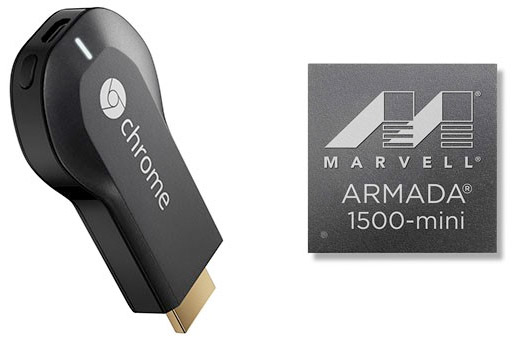What's In Your $35 Chromecast? Marvell's New Armada 1500-mini
Google's Chromecast has made a fairly impressive splash in the TV market, as well as the streaming market. Unlike Google TV, which felt cost prohibitive for most, the $35 Chromecast is well within the impulse buy range for most of its target market. Early reviews on the product have been fairly positive, and you may be wondering what sort of innards are pushing things out. If so, Marvell has the answer.

Marvell today revealed the Armada 1500-mini, a solution that was seemingly built from the ground-up for Chromecast. It was built to support low-power applications (like TV dongles), as well as to provide instantaneous and seamless access to applications such as YouTube, Netflix and other cloud-based content.
Marvell's latest Armada 1500-mini platform is designed to enable sophisticated high quality audio, video, and graphics capabilities, while being extremely energy efficient. The platform facilitates form factors – such as a dongle – that are USB powered. It supports 1080p decode and has a high security grade enabling multiple DRM solutions like Widevine and Playready. With Marvell's advanced Wi-Fi solution, it provides an easy set up and plugs straight into a TV HDMI port.
Now, one has to wonder: will this chip make its way into Intel, Apple, Roku, or any other streaming solution of the future?

Marvell today revealed the Armada 1500-mini, a solution that was seemingly built from the ground-up for Chromecast. It was built to support low-power applications (like TV dongles), as well as to provide instantaneous and seamless access to applications such as YouTube, Netflix and other cloud-based content.
"I am very excited to see the brilliance of the tiny and beautiful Chromecast. I believe this is truly a game-changing solution to drive the new era of the 'Connected Lifestyle' by enabling easy access to online entertainment for an immersive, interactive multi-screen experience across any smartphone, tablet, laptop and big screen. I am very proud of Google's leadership in driving the ecosystem partners to deliver more powerful and very affordable solutions to serve the world of consumers for better lives," said Weili Dai, President and Co-Founder of Marvell. "2013 has been a phenomenal year for bringing online entertainment to TV. I am so thankful for and proud of the joint hard work and innovation by the Marvell team, the Google team and other partners in the ecosystem."
Marvell's latest Armada 1500-mini platform is designed to enable sophisticated high quality audio, video, and graphics capabilities, while being extremely energy efficient. The platform facilitates form factors – such as a dongle – that are USB powered. It supports 1080p decode and has a high security grade enabling multiple DRM solutions like Widevine and Playready. With Marvell's advanced Wi-Fi solution, it provides an easy set up and plugs straight into a TV HDMI port.
Now, one has to wonder: will this chip make its way into Intel, Apple, Roku, or any other streaming solution of the future?

